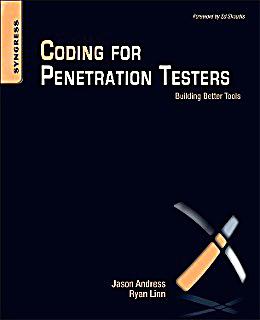Coding for Penetration Testers Building Better Tools
Data: 4.09.2018 / Rating: 4.8 / Views: 974Gallery of Video:
Gallery of Images:
Coding for Penetration Testers Building Better Tools
Coding for Penetration Testers: Building Better Tools, Second Edition provides readers with an understanding of the scripting languages that are commonly used when developing tools for penetration testing, also guiding users through specific examples of custom tool development and the situations where such tools might be used. Coding for Penetration Testers Building Better Tools Jason Andress Ryan Linn Coding for penetration testers: building better tools Jason Andress, Ryan Linn. Through an astonishing scientic breakthrough, our. Free eBook: Coding for Penetration Testers Building Better Tools chm, pdf rapidshare, ebook. Coding for Penetration Testers discusses the use of various scripting languages in penetration testing. The book presents stepbystep instructions on how to build customized penetration testing tools using Perl, Ruby, Python, and other languages. It also provides a primer on scripting including. Coding for Penetration Testers discusses the use of various scripting languages in penetration testing. The book presents stepbystep instructions on how to build customized penetration testing tools using Perl, Ruby, Python, and other languages. Coding for Penetration Testers provides the reader with an understanding of the scripting languages that are commonly used when developing tools for penetration testing. It also guides the reader through specific examples of custom tool development and the situations where such tools might be used. Download: Coding For Penetration Testers Building Better Tools CODING FOR PENETRATION TESTERS BUILDING BETTER TOOLS In this site isnt the. Coding for Penetration Testers: Building Better Tools, Second Edition provides readers with an understanding of the scripting languages that are commonly used when developing tools for penetration testing, also guiding users through specific examples of custom tool development and the situations where such tools might be used. Coding for Penetration Testers: Building Better Tools, Second Edition provides readers with an understanding of the scripting languages that are commonly used when developing tools for penetration testing, also guiding users through specific examples of custom tool development and the situations where such tools might be used. Coding for Penetration Testers: Building Better Tools, Second Edition provides readers with an understanding of the scripting languages that are commonly Coding for Penetration Testers: Building Better Tools, Edition 2 Ebook written by Jason Andress, Ryan Linn. Read this book using Google Play Books app on your PC, android, iOS devices. Download for offline reading, highlight, bookmark or take notes while you read Coding for Penetration Testers: Building Better Tools, Edition 2. Coding for Penetration Testers: Building Better Tools, Second Edition provides readers with an understanding of the scripting languages that are commonly used when developing tools for penetration testing, also guiding users through specific examples of custom tool development and the situations. Description: Coding for Penetration Testers: Building Better Tools, Second Edition provides readers with an understanding of the scripting languages that are commonly used when developing tools for penetration testing, also guiding users through specific examples of custom tool development and the situations where such tools might be used. Coding for Penetration Testers: Building Better Tools, Second Edition provides readers with an understanding of the scripting languages that are commonly used when developing tools for penetration testing, also guiding users through specific examples of custom tool development and the situations where such tools might be used. Coding for Penetration Testers: Building Better Tools, Second Edition provides readers with an understanding of the scripting languages that are commonly used when developing tools for penetration testing, also guiding users through specific examples of custom tool development and the situations. Tools used for penetration testing are often purchased or downloaded from the Internet. Each tool is based on a programming language such as Perl, Python, or Ruby. If a penetration tester wants to extend, augment, or change the functionality of a tool to perform a test differently than the default. Coding for Penetration Testers discusses the use of various scripting languages in penetration testing. The book presents stepbystep instructions on how to build customized penetration testing tools using Perl, Ruby, Python, and other languages. Coding for Penetration Testers: Building Better Tools, Second Edition provides readers with an understanding of the scripting languages that are commonly used when developing tools for penetration testing, also guiding users through specific examples of custom tool development and the situations where such tools might be used. Coding for Penetration Testers: Building Better Tools, Second Edition provides readers with an understanding of the scripting languages that are commonly used when developing tools for penetration testing, also guiding users through specific examples of custom tool development and the situations where such tools might be used. Coding for Penetration Testers discusses the use of various scripting languages in penetration testing. The book presents stepbystep instructions on how to build customized penetration testing tools using Perl, Ruby, Python, and other languages. Coding for Penetration Testers provides the reader with an understanding of the scripting languages that are commonly used when developing tools for penetration testing. It also guides the reader through specific examples of custom tool development and the situations where such tools might be used. coding for penetration testers building better tools are a good way to achieve details about operating certainproducts. Many products that you buy can be obtained using instruction manuals. Coding for Penetration Testers discusses the use of various scripting languages in penetration testing. The book presents stepbystep instructions on how to build customized penetration testing tools using Perl, Ruby, Python, and other languages. Coding for Penetration Testers Building Better Tools JasonAndress Ryan Linn ELSEVIER AMSTERDAM BOSTON HEIDELBERG LONDON NEWYORK OXFORD PARIS SANDIEGO SANFRANCISCO SINGAPORE SYDNEY TOKYO Syngressis animprintofElsevier SYNGRESS Coding for penetration testers: building better tools. [Jason Andress; Ryan Linn Tools used for penetration testing are often purchased or downloaded from the Internet. Each tool is based on a programming language such as Perl, Python, or Ruby. Coding for Penetration Testers: Building Better Tools, Second Edition provides readers with an understanding of the scripting languages that are commonly used when developing tools for penetration testing, also guiding users through specific examples of custom tool development and the situations where such tools might be used. Coding for penetration testers [electronic resource: building better tools. Buy Coding for Penetration Testers: Building Better Tools by Jason Andress, Ryan Linn (ISBN: ) from Amazon's Book Store. Everyday low prices and free delivery on eligible orders. [Editors Note: I had the honor of writing the Forward to the fantastic new book Coding for Penetration Testers: Building Better Tools by Jason Andress and Ryan Linn, published this month. Think of this Forward as part book review and part adventure through a mind overinfluenced by ethical hacking, penetration testing, and movies. Coding for Penetration Testers provides the reader with an understanding of the scripting languages that are commonly used when developing tools for penetration testing. It also guides the reader through specific examples of custom tool development and the situations where such tools might be used. Coding for Penetration Testers: Building Better Tools, Second Edition provides readers with an understanding of the scripting languages that are commonly used when developing tools for penetration testing, also guiding users through specific examples of custom tool development and the situations where such tools might be used. Coding for Penetration Testers: Building Better Tools, Second Edition provides readers with an understanding of the scripting languages that are commonly used when developing tools for penetration testing, also guiding users through specific examples of custom tool development and the situations where such tools might be used. [Editors Note: I had the honor of writing the Forward to the fantastic new book Coding for Penetration Testers: Building Better Tools by Jason Andress and Ryan Linn, published this month. Think of this Forward as part book review and part adventure through a mind overinfluenced by ethical hacking. Coding for Penetration Testers discusses the use of various scripting languages in penetration testing. The book presents stepbystep instructions on how to build customized penetration testing tools using Perl, Ruby, Python, and other languages. Buy Coding for Penetration Testers: Building Better Tools 2 by Jason Andress, Ryan Linn (ISBN: ) from Amazon's Book Store. Everyday low prices and free delivery on eligible orders. Coding for Penetration Testers: Building Better Tools, Second Edition provides readers with an understanding of the scripting languages that are commonly used when developing tools for penetration testing, also guiding users through specific examples of custom tool development and the situations where such tools might be used. Book Review Coding for Penetration Testers: Building Better Tools Below is a review of Coding for penetration testers by Elsevier, written by Jason Andress and Ryan Linn. First I would like to thank the BK community for their contribution in developing my own skills. Coding for Penetration Testers: Building Better Tools, Second Edition provides readers with an understanding of the scripting languages that are commonly used when developing tools for penetration testing, also guiding users through specific examples of custom tool development and the situations where such tools might be used.
Related Images:
- 1983 winners and sinners
- Live the next doctor
- Why You Win Or Lose The Psychology Of Speculation
- 24 season 8 hd
- Tekken dark resurrection
- El Circulo Dave Eggers Pdf
- Ms office spanish
- Brake 2018 nl subs
- Viva la bam season 4
- Captain marvel 017
- The Lighting Book
- Planes y programas de primaria 2011 pdf
- Benedict Wells Het einde van de eenzaamheid
- Ford 7600 Tractor For Sale Craigslist
- The cell fr
- Ella y yo
- Warrior 2018 dutch
- Young jeezy get it
- Prince of tennis another
- Whose line is it anyway s09e04
- Bridge collapse point pleasant wv
- Fast and furious 1 greek sub
- Mc burberry vs blackout crew lyrics download
- Unity Asset SALSA With RandomEyes
- Teaching Speaking A Holistic Approach
- A personal journey lord
- Livro dieta do abdomen david zinczenko
- Fairy tale 44
- Rocky Theme Song Music
- City of gods
- Hall of fame
- Ug Nx Sheet Metal Tutorial Pdf
- Materi perilaku organisasi internasional
- Kids pc game
- Belajar autocad 3d pdf
- Pro tools 11 mac torrent pirate bay
- Oracle 11G Notes Pdf
- Call for heroes
- Garrys mod 13 addons
- Resumen concilio vaticano ii pdf
- Viral Poems
- Indian national anthem
- Take care 2018
- Rocket Science for Babies Baby University
- De Renner
- The Writers Workplace With Readings
- Rosetta stone viet
- Hollywood may 2018
- French montana drink
- Teste Admitere Facultatea De Medicina
- Purge Valve Solenoid Location On
- Minis first time
- Hell on Wheels s05e01
- Trance non stop mix
- Battlestar galactica season 3 complete
- Database systems connolly begg 5th edition
- 3d glasses google
- Limp Bizkit Three Dollar Bill Yall
- House hunters international s48
- Lily open fire
- New sensation p o v
- Chicken Riot
- Lisa gerrard mp3
- The myth dubbed
- Captain america 3d 2018
- The hobbit off
- Roku 2 user manual pdf
- Libro De Autogestion Del Aprendizaje Pdf
- Django 1080p 1080p
- Emergency Lighting Bs5266 Part 1 1988
- Revolution complete season
- No body does it better
- 24 Season 6 Complete
- Sylvania Tv 19 Inch Manual
- Va clubland 16












